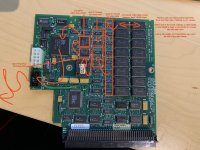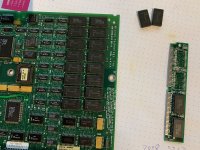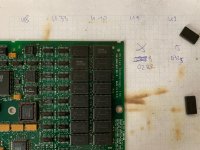So, I was giving this some more thought....
And every avenue of investigation I came up with involved potentially dangerous (temporary) board modifications, because so many things are unknown. For example, one could tie the Chip Enable (CE_) pin on a single memory chip high and see how that affects the image on the screen. That would just require a temporary wire from 5V to the CE pin of a memory chip. The problem with this technique is that at some point a component on the card is going to be trying to sink that line low, and too much amperage to sink, could potentially damage the driver trying to pull it low. Once could pull it high through a resistor, but how much is enough to keep it high, without overloading the driver?
So, probably not a good idea.
But here are a couple of simpler, less invasive ideas....
Check continuity between all of the memory chip CE_ pins. If you find them tied together in some fashion, then that tells you which memory chips are working together as a bank. That's a small start. If they're all separate, then this is a largely useless exercise.
I can't remember if the chips have RAS lines as well, but if they do check those or whatever control lines would be used to signal a read operation and see how they are grouped amongst the memory chips.
Use the oscilloscope to probe the CE_ pins during different resolution depth settings. This will tell you whether all banks of RAM are always used, or whether some are not needed for some resolutions.
Does the oscilloscope you have access to have two or more channels?
Create a pattern of alternating light and dark rows of dots on the screen. Then probe various data pins on the memory chips to see if they're synchronously high and low, or alternating with each other. This will give you some idea of which pins are contributing which rows of data. If you find a pattern, and then test the pattern until you find a break in the pattern. The pin you're probing when you find the break is your likely culprit. If there are no breaks in the pattern, then either you need a different pattern (invert the light and dark dots, e.g.) or the problem is downstream of the memory chips in the buffers which are used to deliver the data to the DACs in proper order.





